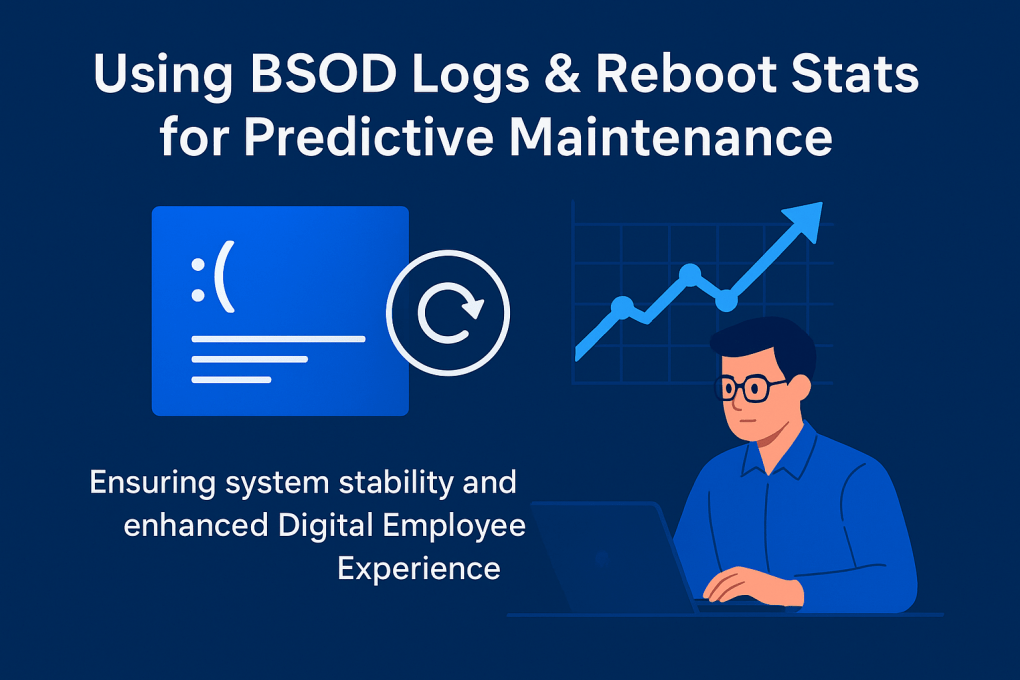Contents
Introduction
Blue Screen of Death (BSOD) logs and reboot statistics are valuable diagnostic signals that can reveal hidden hardware, driver, and application issues before they escalate. By analyzing these logs, IT teams can move from reactive troubleshooting to predictive maintenance, improving system stability, user productivity, and overall Digital Employee Experience (DEX).
Why BSOD Logs and Reboot Stats Matter
A BSOD might seem like an isolated crash, but its log holds detailed insights into what triggered the failure, whether it was a faulty driver, memory leak, or hardware instability. Similarly, frequent reboots can indicate recurring issues like OS corruption, failing updates, or hardware degradation.
- For IT teams: These logs serve as early-warning signals that something in the system is deteriorating.
- For employees: Crashes and reboots disrupt work, cause data loss, and damage trust in IT systems.
- For business leaders: Reduced uptime translates into lost productivity, compliance risks, and higher support costs.
Moving from Reactive Fixes to Predictive Maintenance
Traditionally, IT waits for tickets to be raised after users experience a crash. This reactive approach results in downtime, frustrated employees, and wasted effort. Predictive maintenance flips this model:
- Early detection: Patterns in BSOD error codes and reboot cycles flag issues before they escalate.
- Proactive response: Instead of waiting for complaints, IT can deploy fixes, updates, or guided workflows to prevent failures.
- Continuous learning: Trend analysis across endpoints enables smarter IT decision-making and long-term stability.
Leveraging Anakage for Proactive Monitoring
Anakage’s DEX Monitoring module is designed to capture endpoint signals, including BSOD logs, reboot frequencies, CPU spikes, and RAM overloads – without disrupting user workflows. These insights are automatically aggregated into dashboards that IT admins can act upon.
Key features include:
- Automated Log Collection: BSOD dumps and reboot data are gathered in real time across all endpoints.
- Smart Threshold Alerts: IT gets notified when a reboot or crash exceeds acceptable baselines.
- Root-Cause Insights: Integrated diagnostics help identify whether the cause is driver-related, hardware-specific, or application-driven.
- Integration with ITSM: Incidents can be auto-logged into Anakage’s Gen-AI Powered ITSM, ensuring visibility and streamlined workflows.
This closes the gap between detection and resolution—before employees even notice the problem.
Beyond Monitoring: Guided Remediation at Scale
Predictive maintenance isn’t just about spotting issues; it’s about fixing them quickly and consistently. Anakage extends value beyond monitoring with:
- Guided Walkthroughs: End-users can self-resolve minor reboot/BSOD issues (like driver reinstalls) through step-by-step instructions.
- Smart Agent Automation: IT admins can remotely push fixes, patches, or scripts at scale.
- Compliance Monitoring: Repeated crashes due to unpatched drivers or outdated software are flagged against compliance frameworks.
This dual approach – monitor + remediate – ensures not only uptime but also a smoother, more confident employee experience.
Business Impact of Predictive Maintenance
Harnessing BSOD and reboot data isn’t just a technical advantage; it drives measurable business outcomes:
- Reduced Downtime: Prevent crashes before they halt work.
- Lower Support Costs: Fewer helpdesk tickets and less manual troubleshooting.
- Improved Compliance: Avoid failures tied to patching and security gaps.
- Stronger Employee Confidence: A stable digital environment enhances overall DEX and productivity.
Conclusion
Predictive maintenance using BSOD logs and reboot statistics is a crucial step in transforming IT operations from firefighting to foresight. With Anakage’s DEX Monitoring, Smart Agents, and Guided Walkthroughs, organizations can ensure employees experience fewer disruptions and IT delivers higher value.
This capability directly connects to the broader theme of our main pillar page, “The Modern Guide to Improving Digital Employee Experience (DEX)” where proactive, user-centric IT practices lay the foundation for productivity, trust, and business growth.
Ready to experience the future of DEX?
[Schedule a Personalized Demo Today]
Have you read about our last release? Click here to read!
Frequently Asked Questions (FAQ)
- What is a BSOD log, and why should IT care about it?
A Blue Screen of Death (BSOD) log is a crash dump created when Windows encounters a critical system error. These logs reveal the root cause—such as faulty drivers, hardware failure, or application conflicts—helping IT teams detect patterns and prevent repeat incidents. - How do reboot statistics contribute to predictive maintenance?
Frequent or irregular reboot patterns often indicate deeper issues like unstable updates, memory leaks, or hardware degradation. By monitoring reboot stats, IT can act before these problems impact user productivity or system stability. - How does Anakage help with BSOD and reboot monitoring?
Anakage’s DEX Monitoring module automatically collects BSOD logs and reboot data across endpoints. With real-time dashboards, smart alerts, and ITSM integration, IT teams can proactively resolve issues before they disrupt employees. - Can employees self-resolve BSOD-related issues?
Yes. Using Anakage’s Guided Walkthroughs, employees can follow step-by-step instructions to resolve common issues like driver updates or system resets—reducing downtime and dependency on IT support. - What’s the difference between reactive and predictive IT maintenance?
- Reactive: IT responds after users report an issue, leading to downtime and frustration.
- Predictive: IT analyzes endpoint signals (BSOD logs, reboot cycles, CPU spikes) to detect risks early and apply fixes before disruptions occur.
- Does predictive maintenance reduce support costs?
Absolutely. By preventing issues from reaching the helpdesk, predictive maintenance lowers ticket volumes, reduces manual troubleshooting, and cuts operational costs while improving employee experience. - How does this approach connect to Digital Employee Experience (DEX)?
Every crash or unexpected reboot disrupts workflows, damages trust in IT, and reduces productivity. Predictive maintenance ensures smoother, more reliable digital environments, directly enhancing the overall DEX strategy.

